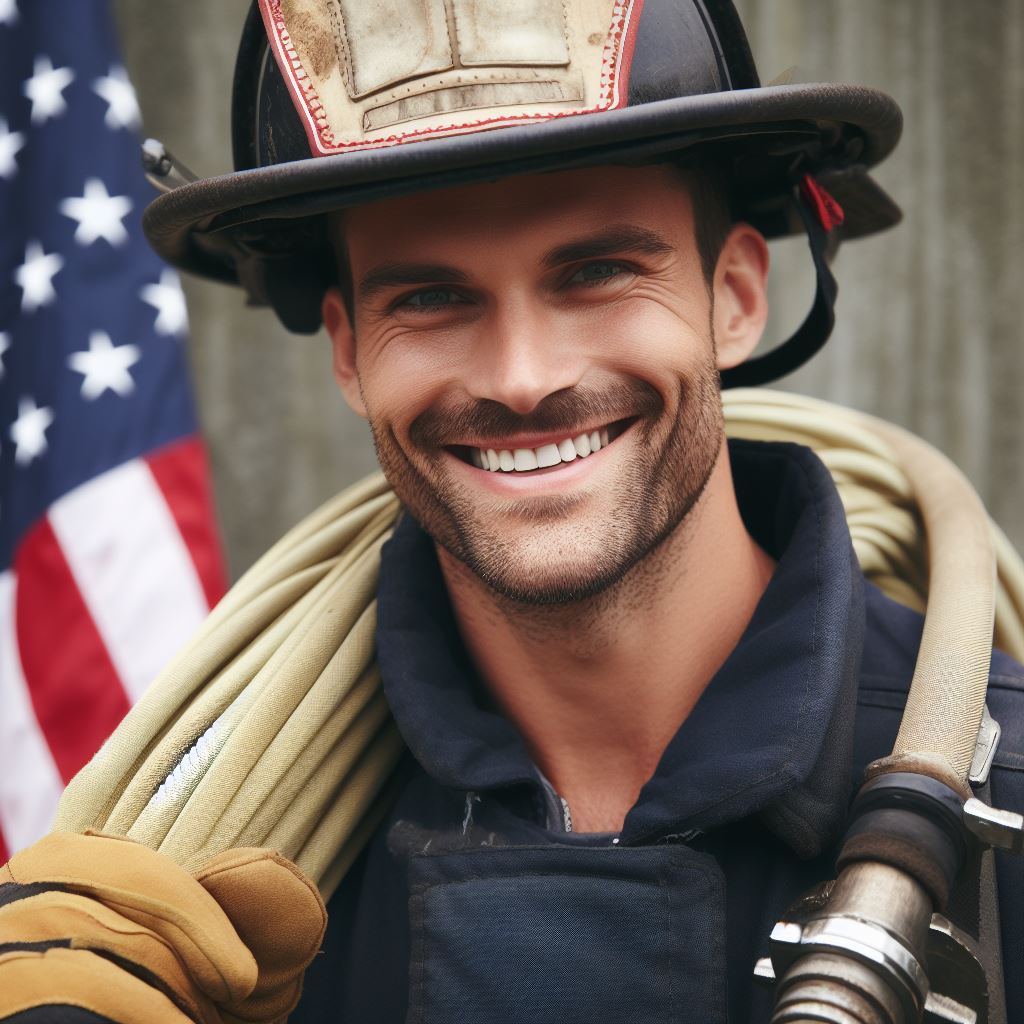Introduction
The importance of fire Academy training for New Recruits
In this blog section, we will discuss the importance of fire academy training for new recruits.
Fire academy training is crucial for new recruits as it provides them with essential skills and knowledge needed in their profession.
This training covers various aspects such as firefighting techniques, emergency response protocols, and physical fitness training.
Additionally, recruits will learn about fire behavior, hazardous materials, and search and rescue operations. The training also focuses on teamwork, leadership, and communication skills.
Throughout the training, recruits will undergo rigorous physical and mental exercises to prepare them for real-life scenarios.
They will participate in hands-on drills and simulations to practice their skills and enhance their problem-solving abilities.
Moreover, recruits will be trained in the proper use of firefighting equipment and tools, including hoses, ladders, and breathing apparatus.
The training program also emphasizes the importance of safety precautions and risk management.
Recruits will learn to assess potential hazards and take appropriate measures to ensure the safety of themselves and others.
The ultimate goal of fire academy training is to produce competent and confident firefighters who are well-prepared to handle any emergency situation.
In the following sections, we will delve into each topic in more detail to give new recruits a comprehensive understanding of what to expect during their fire academy training.
Preparing for Fire Academy Training
Before starting their journey towards becoming a firefighter, new recruits must adequately prepare themselves.
This process includes meeting physical fitness requirements, developing a strong mental mindset, and obtaining the necessary certifications and prerequisites.
Physical fitness requirements
- Recruits must possess a high level of physical fitness to endure the demands of firefighting.
- They should engage in regular exercise routines that focus on cardiovascular endurance, strength, and flexibility.
- Training may include activities such as running, climbing stairs, carrying heavy loads, and performing functional movements.
- Recruits must adhere to specific fitness standards set by the fire academy, which may include timed runs, push-ups, sit-ups, and a flexibility assessment.
- Physical fitness is crucial as it ensures the recruits can respond effectively to emergencies and safeguard themselves and others.
Mental preparation and mindset
- Firefighting is a mentally challenging profession, and new recruits must develop a strong mindset.
- They should anticipate high-pressure situations and mentally prepare to handle them with composure.
- Recruits must adopt a positive attitude and cultivate resilience to overcome obstacles they may encounter during their training.
- Mental preparation involves learning to stay focused, following instructions precisely, and making quick and sound decisions.
- Developing critical thinking skills and problem-solving abilities is essential for effective firefighting operations.
Required certifications and prerequisites
- Prior to entering the fire academy, new recruits must meet certain certifications and prerequisites.
- Many fire departments require recruits to hold a valid CPR and First Aid certification.
- Recruits may also need to obtain an Emergency Medical Technician (EMT) certification.
- Some academies require completion of a written exam and an interview process to assess the recruits’ suitability.
- Fulfilling these certifications and prerequisites ensures that recruits have the necessary foundational knowledge before entering the academy.
By thoroughly preparing themselves, new recruits can maximize their potential for success in fire academy training.
This includes meeting physical fitness requirements, developing a strong mental mindset, and acquiring the required certifications and prerequisites.
Such preparation will lay a solid foundation for recruits to handle the rigorous training and challenges they will face as they begin their journey to become firefighters.
Structure and Duration of Fire Academy Training
Fire academy training is a comprehensive program that prepares new recruits for their future as firefighters.
Overview of the training program
- The training program covers a wide range of skills and knowledge required in the firefighting profession.
- Recruits are introduced to essential firefighting techniques, equipment operation, and emergency protocols.
- They also learn about fire behavior, hazardous materials, and how to respond to various emergency situations.
- The program emphasizes physical fitness, teamwork, and leadership skills to ensure a well-rounded training experience.
Length of the training program
- The duration of fire academy training varies depending on the region and the specific academy.
- On average, the program lasts between 12 to 16 weeks, providing recruits with intensive training.
- This timeframe allows recruits to develop the necessary skills and knowledge required in firefighting.
- Some academies may have extended programs that span several months to provide additional specialized training.
Classroom instruction vs. practical training
- Fire academy training consists of a balance between classroom instruction and practical hands-on training.
- Classroom instruction covers theoretical aspects such as fire science, building construction, and emergency procedures.
- Recruits learn about fire codes, firefighting tactics, and the proper use of firefighting equipment through lectures and discussions.
- Practical training involves hands-on exercises, simulations, and drills to apply the knowledge gained in the classroom.
- Recruits practice using firefighting equipment, conducting search and rescue operations, and extinguishing different types of fires.
- This hands-on experience helps develop muscle memory and builds confidence in handling real-life emergency situations.
- Both classroom and practical training are crucial for comprehensive firefighter training.
In review, fire academy training offers a structured and intensive program to equip new recruits with the necessary skills and knowledge for their future careers as firefighters.
The program includes a diverse range of subjects, physical fitness training, and emphasis on teamwork.
The duration of the training varies but typically lasts for 12 to 16 weeks.
Classroom instruction provides theoretical knowledge while practical training allows recruits to apply what they have learned in real-life scenarios.
Through this comprehensive training, new recruits are prepared to face the challenges of firefighting and ensure the safety of their communities.
Topics Covered in Fire Academy Training
Firefighting techniques and strategies
- Recruits learn various firefighting techniques such as extinguishing different types of fires.
- They are taught how to use fire hoses, nozzles, and other firefighting equipment effectively.
- Training includes strategies for fire attack, ventilation, and search and rescue operations.
- Recruits practice deploying and controlling hose lines to suppress fires efficiently.
- They learn about incident command systems and the importance of teamwork in firefighting.
Fire behavior and science
- Recruits study the behavior of fire, including how it spreads and reacts in different situations.
- They learn about the chemistry of fire and the factors that influence its growth and intensity.
- Training covers the effects of ventilation, fuel types, and weather conditions on fire behavior.
- Recruits understand the importance of recognizing fire patterns and predicting fire behavior.
- They learn techniques to anticipate flashover and backdraft situations to ensure firefighter safety.
Equipment and apparatus operation
- Recruits gain knowledge about operating and maintaining firefighting tools and equipment.
- They learn how to properly use ladders, power tools, and ventilation devices during emergencies.
- Training includes operating fire trucks, aerial ladder platforms, and other specialized apparatus.
- Recruits practice pump operations and learn to establish and manage water supply systems.
- They understand the importance of regular equipment inspections and maintenance.
Emergency medical training
- Recruits receive basic medical training to provide immediate care to injured individuals.
- They learn CPR, first aid, and techniques to treat common injuries and medical emergencies.
- Training covers the use of medical equipment like defibrillators and oxygen administration.
- Recruits understand the importance of quick and accurate patient assessment in emergency situations.
- They gain the skills to stabilize patients until advanced medical personnel arrive.
Hazardous materials response
- Recruits learn how to handle hazardous substances and respond to incidents involving dangerous materials.
- They study the different classifications and properties of hazardous materials.
- Training covers proper personal protective equipment (PPE) usage and decontamination procedures.
- Recruits understand how to identify and isolate hazardous material leaks or spills effectively.
- They learn about the protocols for reporting, containment, and cleanup of hazardous material incidents.
Search and rescue techniques
- Recruits are trained in various search and rescue techniques to locate and extract victims.
- They learn how to conduct primary and secondary searches in smoke-filled and collapsed structures.
- Training includes using specialized equipment like thermal imaging cameras and search ropes.
- Recruits practice techniques for removing victims from confined spaces or collapsed buildings.
- They understand the importance of rapid and efficient search and rescue operations.
Building construction and safety codes
- Recruits gain knowledge about different types of building construction and their potential hazards.
- They learn to identify structural weaknesses and potential collapse risks in various buildings.
- Training covers the importance of adhering to fire safety codes and regulations.
- Recruits understand the significance of conducting pre-incident surveys to plan effective firefighting strategies.
- They learn about fire protection systems, building materials, and the importance of fire-resistant construction.
In a comprehensive fire academy training program, new recruits are exposed to a wide range of topics.
Learning firefighting techniques, fire science, equipment operation, emergency medical training, hazardous materials response, search and rescue, and building codes is essential.
This extensive training equips them with the necessary skills and knowledge to handle various emergency situations efficiently and effectively.
Read: Adapting to Civilian Life: Tips for Returning Veterans
Physical Demands of Fire Academy Training
Achieving and maintaining top physical condition is an essential aspect of fire academy training.
Fitness tests and physical training
- Recruits are required to undergo rigorous fitness tests to assess their physical capabilities.
- These tests include timed runs, sit-ups, push-ups, and obstacle courses to measure strength and agility.
- Physical training sessions are conducted daily, focusing on cardiovascular endurance, strength, and flexibility.
- Trainees participate in drills, circuit training, and weightlifting exercises to improve overall physical fitness.
- Maintaining a healthy lifestyle and proper nutrition is emphasized throughout the training program.
Gear and equipment handling
- Firefighters-in-training learn to properly handle and use firefighting gear and equipment.
- The equipment includes heavy gear such as helmets, masks, gloves, and self-contained breathing apparatus (SCBA).
- Trainees practice putting on and taking off the gear quickly and efficiently to simulate real-life emergency situations.
- Handling equipment like hoses, ladders, and fire extinguishers is an integral part of the training process.
- Trainees are taught the correct techniques for carrying, deploying, and operating various firefighting tools.
Endurance and stamina requirements
- Fire academy training demands exceptional endurance and stamina from recruits.
- Trainees must be able to withstand physically demanding tasks for extended periods.
- They experience intense physical activities such as running, climbing stairs, and carrying heavy loads.
- Simulated rescue operations and live-fire training exercises require endurance and mental fortitude.
- Recruits are pushed to their limits to simulate the stress and physical demands of real firefighting situations.
Fire academy training challenges every aspect of a recruit’s physical abilities, preparing them for the demands of the job.
Read: Financial Planning for U.S. Military Personnel & Families

Discover More: Fire Prevention and Community Outreach in the U.S.
Skills and Competencies New Recruits Will Develop
Teamwork and Communication Skills
- New recruits will undergo rigorous training that emphasizes the importance of teamwork.
- They will learn effective communication techniques to relay vital information during emergency situations.
- Teamwork exercises will help them develop trust and establish efficient communication channels.
- Recruits will also learn how to effectively collaborate with colleagues while working in high-stress situations.
Decision-making and Problem-solving Abilities
- Fire academy training aims to enhance recruits’ decision-making skills to make quick and effective choices.
- They will be exposed to various scenarios where they must assess the situation and make correct decisions.
- Problem-solving exercises will challenge them to think critically and find innovative solutions.
- Recruits will learn to prioritize tasks, troubleshoot issues, and adapt to unexpected challenges.
Leadership and Accountability
- The fire academy training will nurture leadership qualities in new recruits.
- They will learn how to take charge and guide their team during emergency response operations.
- Recruits will also cultivate a sense of accountability, understanding the consequences of their actions.
- They will be trained to handle responsibilities and become reliable members of their firefighting unit.
Technical Skills Related to Firefighting and Emergency Response
- New recruits will acquire essential technical skills necessary for firefighting and handling emergencies.
- They will learn proper handling and usage of firefighting equipment, such as hoses, axes, and breathing apparatus.
- Training will cover techniques for extinguishing different types of fires, including structural, wildland, and chemical fires.
- Recruits will receive instruction on conducting search and rescue operations and administering basic first aid.
By the end of the training program, new recruits will possess a well-rounded skill set, allowing them to effectively respond to various emergency situations.
They will be equipped with the knowledge and competence required to work as part of a team, ensuring the safety of themselves and others.
Teamwork and communication skills are crucial in firefighting, as emergencies require coordinated efforts.
The training emphasizes effective communication techniques to ensure clear and concise information exchange among team members.
Recruits will also participate in team-building exercises, fostering a cohesive and efficient working environment.
The decision-making and problem-solving abilities of new recruits will be honed through realistic scenarios. By facing simulated emergencies, they will learn to assess situations quickly and make informed decisions.
This training instills the confidence to handle unexpected challenges and find effective solutions.
Leadership skills are essential for firefighters who often find themselves in positions of authority during emergency operations.
Recruits will receive training on how to take charge and make decisive decisions while considering the safety of their team and victims.
They will understand the importance of being accountable for their actions and leading by example.
Technical skills form the foundation of a firefighter’s role. New recruits will be trained in the proper use of firefighting equipment, ensuring their effectiveness in combating fires and minimizing risks.
They will receive hands-on training in various firefighting techniques and emergency response protocols to handle diverse situations successfully.
Read: The Role of the U.S. Coast Guard: Beyond Sea Rescues
Discover More: Tools & Tech: The Modern Police Officer’s Toolkit
Challenges and Rewards of Fire Academy Training
Physical and Mental Challenges
- Intense physical training: Recruits undergo rigorous physical exercises to build endurance and strength.
- Overcoming fears: Fire Academy pushes recruits to confront their fears and develop mental resilience.
- Stressful situations: Trainees are exposed to simulated high-pressure scenarios to test their decision-making abilities.
- Long hours and sleep deprivation: Firefighters must learn to function effectively while sleep-deprived.
Camaraderie and Sense of Belonging
- Teamwork: Recruits learn to rely on each other during training exercises, forging strong bonds.
- Shared experiences: Going through the Fire Academy together creates a unique understanding among trainees.
- Trust and support: The fire service encourages a culture of trust, where firefighters rely on one another.
- Brotherhood/sisterhood: The sense of belonging to a tight-knit community fosters lifelong friendships.
Personal Growth and Fulfillment
- Learning new skills: Trainees acquire valuable firefighting techniques, enhancing their professional abilities.
- Pushing boundaries: Fire Academy challenges recruits to push past their limits, promoting personal growth.
- Confidence boost: Overcoming physical and mental challenges boosts self-esteem and confidence levels.
- Making a difference: Firefighters find fulfillment in serving the community and saving lives.
In essence, Fire Academy training offers a range of challenges and rewards for new recruits.
The intense physical and mental challenges push trainees to their limits, helping them develop resilience and overcome fears.
The camaraderie and sense of belonging fostered through teamwork and shared experiences create lifelong bonds.
Additionally, the personal growth and fulfillment that come from learning new skills, pushing boundaries, and making a difference in the community make the journey through the Fire Academy truly worthwhile.
Read: Post-Traumatic Stress Disorder (PTSD) in Military Vets
Transform Your Career Today
Unlock a personalized career strategy that drives real results. Get tailored advice and a roadmap designed just for you.
Start NowUncover the Details: Top U.S. Cities with the Highest Demand for Security Personnel
Conclusion
Let’s recap the main points we have discussed throughout this blog section. We have explored what new recruits can expect during their fire academy training.
The training covers various aspects like physical conditioning, firefighting techniques, and emergency response. Recruits also undergo rigorous drills and simulations to prepare them for real-life scenarios.
Additionally, they learn about equipment usage, communication systems, and teamwork. The fire academy training demands dedication, discipline, and mental resilience from recruits.
It is important for aspiring firefighters to understand the challenges they may face during this training. However, with determination and a strong passion for the profession, they can overcome any obstacles.
Pursuing fire academy training is a rewarding experience that can lead to a fulfilling career. The training equips recruits with the necessary skills and knowledge to serve and protect their communities.
Aspiring firefighters should not be discouraged by the demanding nature of the training. Instead, they should view it as an opportunity to grow, learn, and become part of an honorable profession.
By joining the fire academy, they embark on a path that allows them to make a meaningful impact in people’s lives.
In summary, if you have a burning desire to become a firefighter, don’t hesitate to pursue fire academy training.
The challenges you will face will create a strong foundation for a rewarding and fulfilling career.
[E-Books for Sale]
The Big Book of 500 High-Paying Jobs in America: Unlock Your Earning Potential
$19.99 • 500 High-Paying Jobs • 330 pages
Explore 500 high-paying jobs in America and learn how to boost your career, earn more, and achieve success!
See All 500 High-Paying Jobs of this E-Book
1001 Professions Without a Degree: High-Paying American Jobs You Can Start Now
$19.99 • 1001 Professions Without a Degree • 174 pages
Discover 1001 high-paying jobs without a degree! Unlock career tips, skills, and success strategies for just $19.99!




